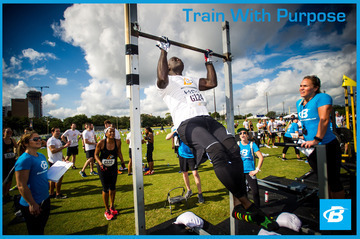Train with Purpose: Strength Tips from a Giant
April 25, 2018
Professional powerlifter Mark Bell has benched 832 pounds. He gave Bodybuilding.com contributor Hobart Swan tips for taking your lifts to the next level.
Take The Bar Through A "J' Path
When you take the bar off the rack, you bend your arms to bring the bar to your chest. Bell says to flex your chest as high as you can while keeping your lats tight. As you come out of the bottom of the bench, flare out your lats to recruit their maximum power. Aim to push up and back toward your neck, following a kind of "J" shape to take advantage of your body's biodynamics.
"Try to keep your wrists straight, and keep your elbows and your wrists on the downhill side of the bar—the side your hips and legs are on," Bell says. "Make sure your elbows are tucked into your sides before you lift. This will bring your lats into play, make you more stable on the bench, and contribute speed and power to the press."
Don't Overlift At The Top End
Bell says it's common for lifters to want to explode out of the bottom of the press—and then just keep going. Explosion is great; keep working to develop it. But push your arms too high and your biomechanical advantage vanishes.
"When you notice that you're overlifting like that, correct it by pulling your chest up and away from the bench, bringing your arms down and in to lock in your shoulder blades and flexing your lats to get them engaged,” Bell advises.
Experiment With Lifting Shoes
If you've never tried them, Mark suggests giving Olympic lifting shoes a test drive to see if they improve your stability and power. These shoes can be quite a change from normal gym shoes, but with time, they can improve your press.
"Bench presses can put your lower body in awkward positions," Bell warns. "Ideally, keep your feet wide to create a good foundation, positioning them right under your knees or your hamstrings. Keeping your heels on the floor improves your stability and adds more power to your bench."
Getting your body into this position can be hard on your hips and can sometimes even cause cramping. Bell suggests doing hip-loosening exercises before you hit the bench.
Improve Your Lockout
Many lifters hit sticking points as they push the bar back up toward the rack. Bell has a few tips for developing the strength you need to push through these points en route to lockout: Practice the exercise with lower weights using a close grip.
For the full article including four more lifting tips from Mark Bell, click here. Take The Bar Through A "J' Path
When you take the bar off the rack, you bend your arms to bring the bar to your chest. Bell says to flex your chest as high as you can while keeping your lats tight. As you come out of the bottom of the bench, flare out your lats to recruit their maximum power. Aim to push up and back toward your neck, following a kind of "J" shape to take advantage of your body's biodynamics.
"Try to keep your wrists straight, and keep your elbows and your wrists on the downhill side of the bar—the side your hips and legs are on," Bell says. "Make sure your elbows are tucked into your sides before you lift. This will bring your lats into play, make you more stable on the bench, and contribute speed and power to the press."
Don't Overlift At The Top End
Bell says it's common for lifters to want to explode out of the bottom of the press—and then just keep going. Explosion is great; keep working to develop it. But push your arms too high and your biomechanical advantage vanishes.
"When you notice that you're overlifting like that, correct it by pulling your chest up and away from the bench, bringing your arms down and in to lock in your shoulder blades and flexing your lats to get them engaged,” Bell advises.
Experiment With Lifting Shoes
If you've never tried them, Mark suggests giving Olympic lifting shoes a test drive to see if they improve your stability and power. These shoes can be quite a change from normal gym shoes, but with time, they can improve your press.
"Bench presses can put your lower body in awkward positions," Bell warns. "Ideally, keep your feet wide to create a good foundation, positioning them right under your knees or your hamstrings. Keeping your heels on the floor improves your stability and adds more power to your bench."
Getting your body into this position can be hard on your hips and can sometimes even cause cramping. Bell suggests doing hip-loosening exercises before you hit the bench.
Improve Your Lockout
Many lifters hit sticking points as they push the bar back up toward the rack. Bell has a few tips for developing the strength you need to push through these points en route to lockout: Practice the exercise with lower weights using a close grip.
- Practice incline presses, which take much of the arch out of the position and force you to meet the weight head-on. Avoid cheating the lift by using hip thrusts to lift the weight.
- Practice overhead exercises along with exercises that develop your triceps. A good example is the overhead triceps extension using a rope attachment.
